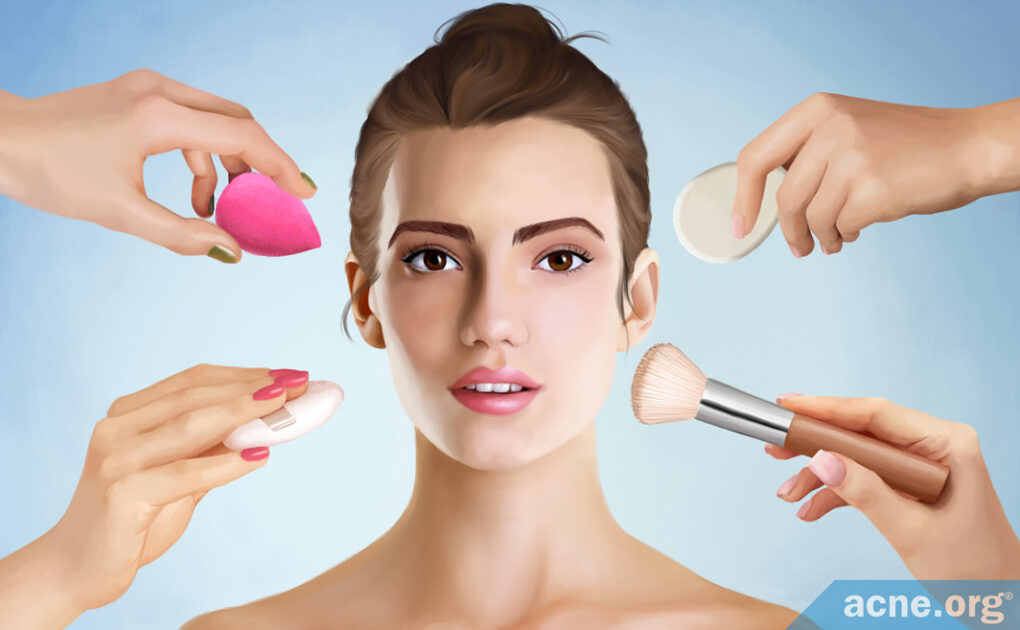Probably Not, but Irritating the Skin with Stiff Cosmetic Tools May Make Acne Worse. Always Choose Soft Makeup Tools and Be as Gentle as Possible.

The Essential Info
No research studies have been performed to determine if makeup tools can lead to acne. However, there is strong evidence that rubbing the skin can irritate it and make acne worse, so it is important to stay gentle when using makeup tools on acne-prone skin.
Stay Gentle: To avoid irritating the skin when you apply makeup, use your fingers instead of brushes, sponges, pads, or puffs whenever you can. If you need to use a makeup tool, choose the softest one you can and stay as gentle as possible when using it.
Wash Tools: Wash your cosmetic tools regularly. Check the packaging when you buy a tool and clean it according to the manufacturer’s instructions. If there are no instructions, wash brushes once a week, sponges after each use, and pads/puffs once a month. Use any mild facial cleanser or baby shampoo to wash, rinse well with water, and air dry.
Replace Tools: Replace worn-out tools regularly, especially if they end up feeling rougher on the skin over time.

The Science
- Brushes – Choosing & Using a Brush
- Sponges – Choosing & Using a Sponge
- Pads and Puffs – Choosing & Using a Pad or Puff
- Studies
- The Bottom Line
It might seem to make common sense that reusing makeup tools that are not washed between uses would be bad for acne because of the residue left on the tool. However, any residue that might be left on makeup tools is unlikely to directly cause acne. Instead, what is more important to be aware of is the physical irritation that makeup tools can cause when they come into contact with the skin. It is well known that anything that rubs the skin or comes into prolonged contact with the skin can aggravate acne. This includes tools for applying foundations, face powders, concealers, bronzers, and blushes.
Use Your Fingers When You Can
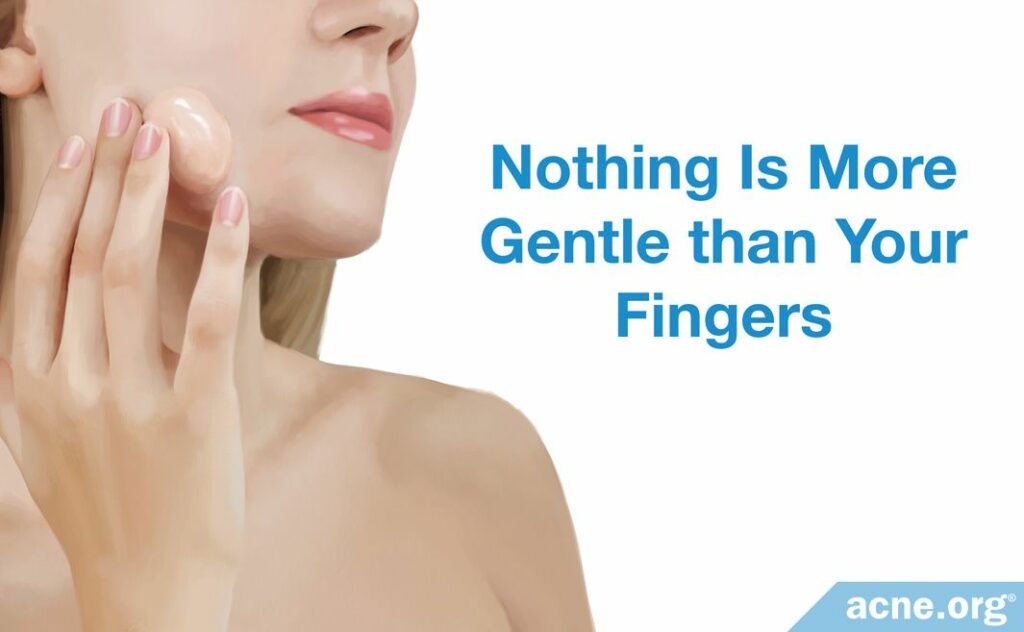
The best tools for applying many of these makeup products are the fingers, because it is easy to control the pressure and stay very gentle when using your fingers. However, for some makeup products, like pressed powder, using the fingers is awkward, and you may need to use a brush, sponge, or puff.
Makeup Tools Should be Soft and Clean
When it comes to acne-prone skin, the ideal makeup tools are:
- Soft, to avoid physically irritating (rubbing, scraping, or pulling) the skin. There is strong evidence that physical irritation can make acne worse. Scientists recognized this several decades ago, as we can see from this article, published in 1975 in the journal Archives of Dermatology:
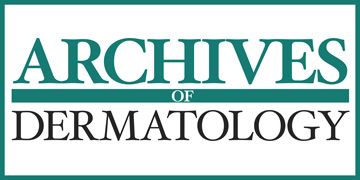
“In this report we wish to emphasize [a] factor that clearly intensifies acne, namely mechanical forces. Among these is pressure, tension, friction, rubbing, pinching, or pulling, or almost any type of [physical] stress on the skin.”1
- Clean, to avoid contaminating the skin with bacteria. While there is currently no evidence that bacteria on makeup tools can contribute to acne, if you have an open sore or cut on your skin, it is important to keep the area free of bacteria in order to avoid infection.
Brushes – Choosing & Using a Brush
Makeup brushes are used for applying powder, liquid, or cream makeup to the skin. Most makeup brushes have names according to their function: for example, “foundation brush,” although some brushes are multi-purpose. Whatever the function of a particular makeup brush, it should be soft and used gently to avoid irritating acne-prone skin.
Makeup brushes consist of:
- A handle, which can be either wooden or plastic.
- Bristles, which can be natural, synthetic, or a hybrid of both. The shape of the brush head can be straight, angular, round, flat, or tapered, depending on the intended use of the brush.2
Since the bristles are the part that comes in contact with the face, let’s consider the pros and cons of natural and synthetic bristles.
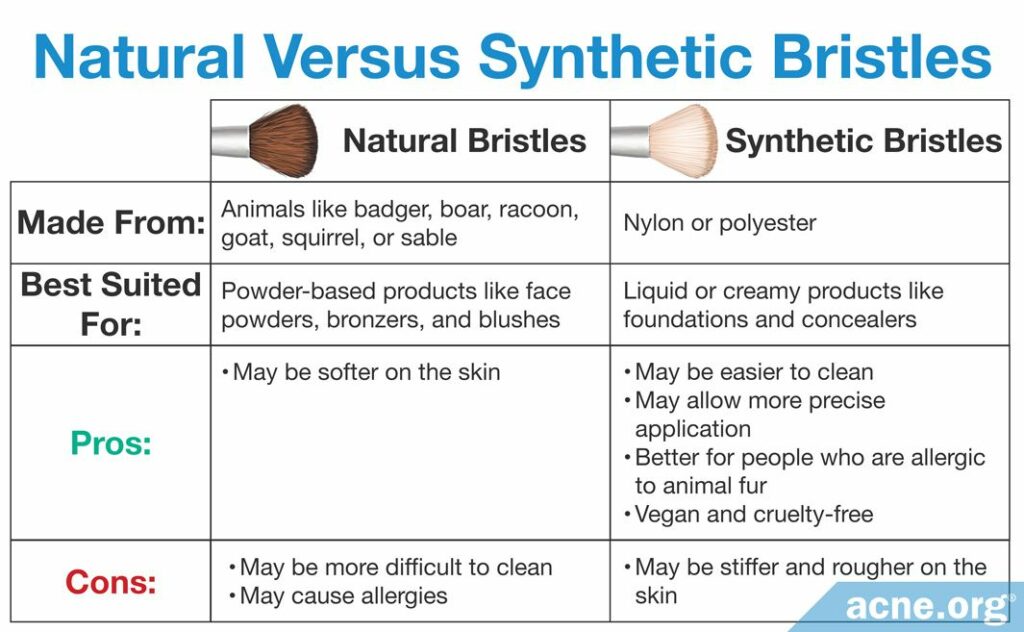
As you can see, natural and synthetic brushes each have their advantages and disadvantages for people with acne. While natural brushes tend to be softer, which is preferable for acne-prone skin, synthetic brushes tend to be easier to clean, which is important if you have any open sores on your skin.
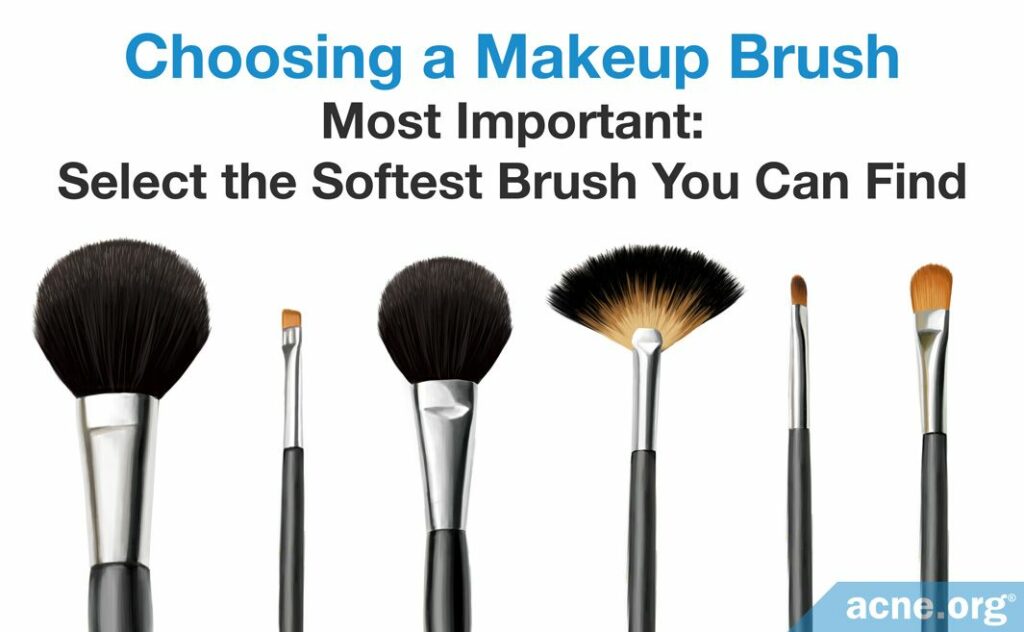
Select the softest brush: Depending on the type of makeup you need to apply and considerations such as allergies, you may decide on either natural or synthetic bristles, or even a hybrid brush containing both types of bristles. Regardless of which type of bristles you use, select the softest brush and use it gently.
Wash your brushes regularly: There are no scientific studies to give us recommendations for how often makeup brushes should be washed. Some manufacturers recommend cleaning brushes once a week if used daily, while some makeup artists believe that cleaning brushes once every month or two is sufficient.3
Some manufacturers market cleaning products along with their makeup brushes and provide cleaning instructions. If the manufacturer of your makeup brush does not provide any cleaning instructions, you can wash your brush with any mild facial cleanser or baby shampoo. Afterwards, rinse the brush well with water and allow to air-dry. While a dirty brush is unlikely to cause acne, it could introduce bacteria into any open sores or cuts on your skin and potentially lead to an infection.
Replace worn-out brushes: Although makeup brushes do not have a specific expiration date, a brush should be replaced if it breaks, sheds bristles, looks misshapen, or does not work as well as it did when first purchased. This is important because an old brush is more likely to irritate the skin and make acne worse.
Sponges – Choosing & Using a Sponge
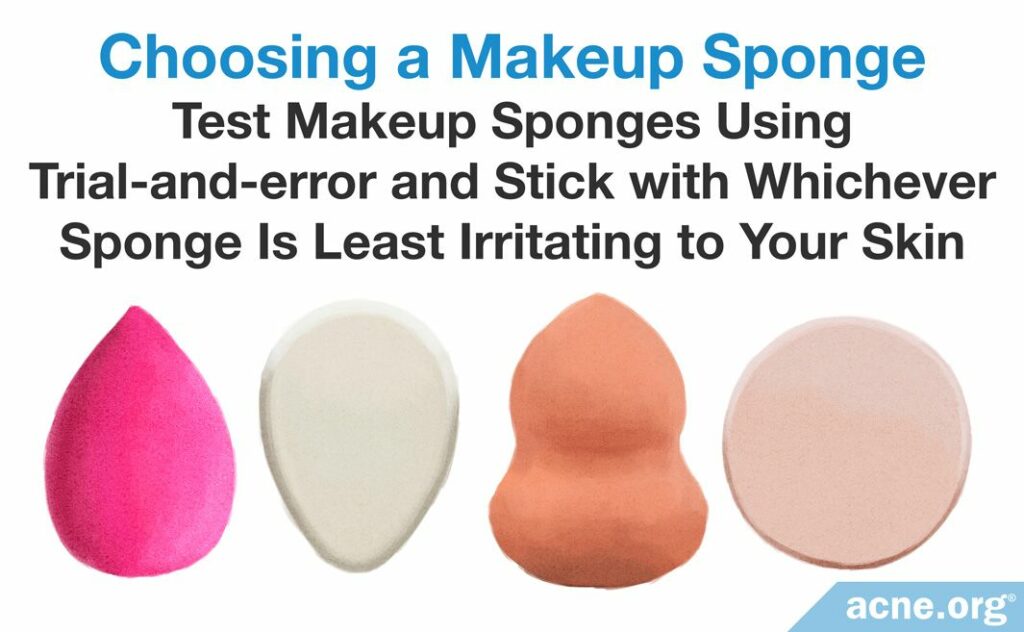
Makeup sponges are tools for applying liquid products such as foundation and are useful for blending. Sponges come in a variety of shapes, such as egg- or wedge-shaped.3,4
Makeup sponges can be either disposable or reusable. Some contain latex, while others are latex-free.
Test sponges for irritation: Sponges with fine pores tend to the gentlest and best for acne-prone skin. The size of the pores may be difficult to tell by looking at sponges, so you may need to determine this by trial-and-error. Test each sponge by using it for a while, and eliminate it if it seems to irritate the skin. If you are allergic to latex, opt for latex-free sponges.
Throw out or clean your sponges regularly: Throw out disposable sponges after each use. For reusable sponges, follow the manufacturer’s instructions for cleaning. If the manufacturer has not provided any instructions, simply wash after each use with any facial cleanser or baby shampoo. Then rinse well and air dry.
Replace misshapen or damaged sponges: Some manufacturers provide instructions on how often their sponges should be replaced. If the manufacturer of your sponge has not provided any instructions, use your common sense and replace any sponge that loses its shape or becomes impossible to clean. A sponge that is misshapen or crusted with old makeup is more likely to irritate the skin and make acne worse.
Pads and Puffs – Choosing & Using a Pad or Puff
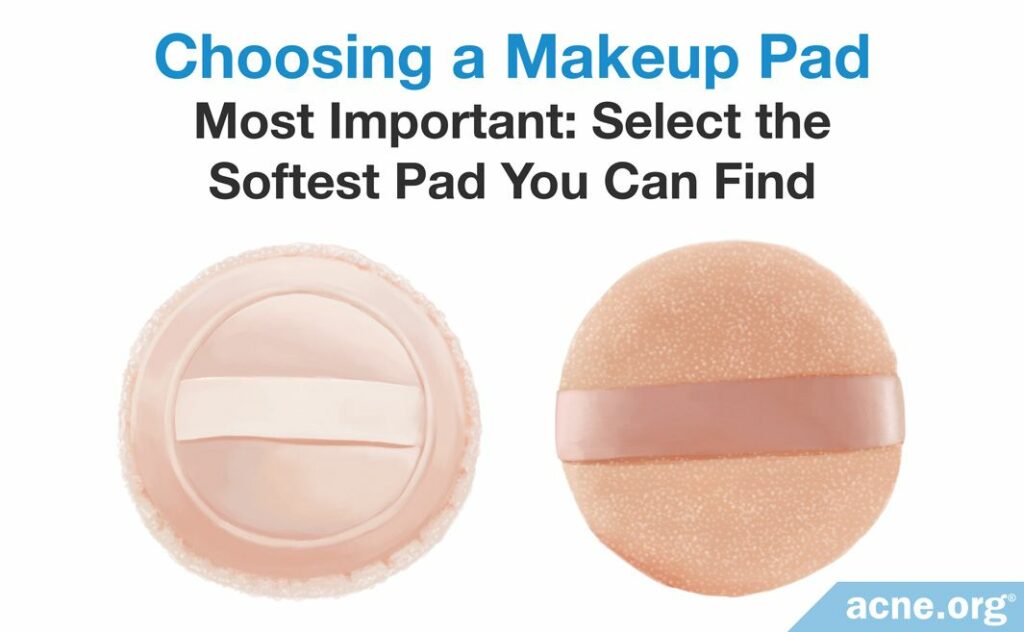
Makeup pads and puffs are tools for applying pressed or loose powders. People typically use pads and puffs for setting or touching up the makeup.3,4 Most pads and puffs are made from cotton or velour and are reusable (washable).
Select the softest pads and puffs: As with other makeup tools, purchase the softest pads and puffs you can find and use them gently on the face.
Wash the pad or puff regularly: Follow the manufacturer’s instructions for cleaning, if available. Otherwise, use “soapy” hot water to wash the pad or puff, but don’t use soap. Instead, use any facial cleanser or baby shampoo. Then rinse well and air dry. Do this at least once a month.
Replace misshapen or damaged pads and puffs: Some manufacturers provide instructions on how often their pads or puffs should be replaced. If no such instructions are available, use your common sense and replace any pad or puff that loses its shape or becomes impossible to clean, since it could irritate your skin and make acne worse.
Studies
No scientific studies have directly looked at what type of cosmetic tool is the best for acne-prone skin. However, two studies give us some clues that may help to guide our selection of makeup tools:

A study published in 2015 in the Journal of Forensic Science compared face makeup sponges, brushes, pads, and other makeup tools. The researchers looked at which makeup tool removes the most skin cells from the skin surface, and found that sponges removed the most skin cells. This might suggest that sponges are less gentle than other makeup tools, and that acne-prone people should use brushes instead of sponges. However, the researchers noted that the sponges also had a larger surface area than the brushes. In other words, perhaps the sponges picked up more skin cells simply because the sponges were in contact with more skin.5 In addition, newer sponges that have appeared on the market after the study was completed may be gentler than the sponges the researchers used. To sum up, the results of this study do not necessarily mean that sponges are worse for acne-prone skin than brushes, but it is important to use caution and select the softest makeup tools available for your purpose.

A study published in 2012 in the Journal of Scientific Research tested 100 used makeup sponges and brushes for the presence of bacteria and fungi. The researchers did not test for acne bacteria, called C. acnes. Instead, they looked at two other common types of bacteria, Staphylococcus aureus and Pseudomonas aeruginosa. The researchers found that all of the used makeup tools were contaminated with at least one type of bacteria.6
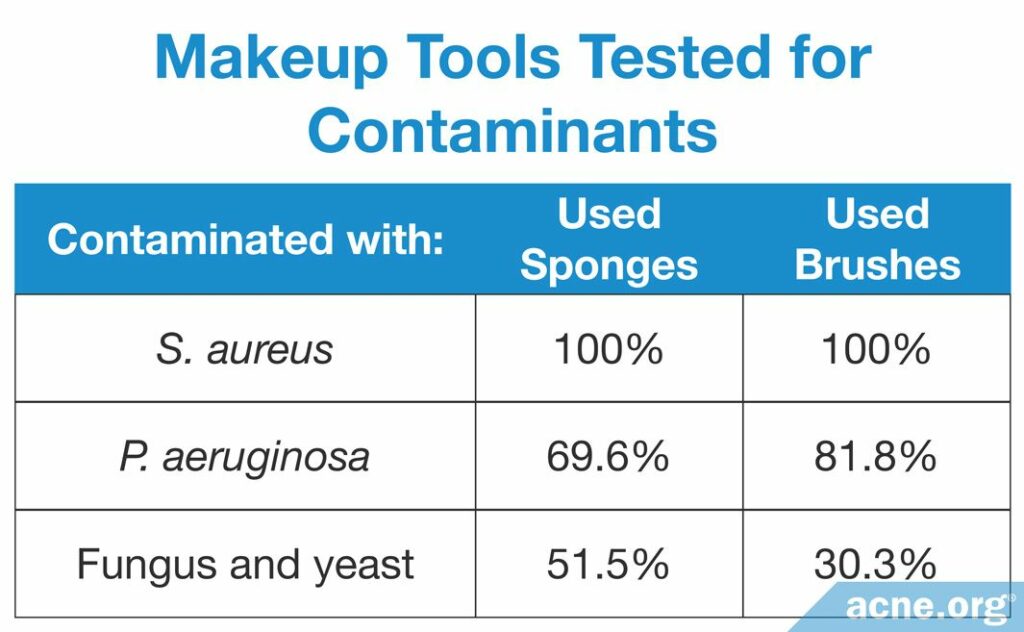
These results suggest that both sponges and brushes can easily become contaminated. While there is currently no evidence that bacteria or fungus on makeup tools can contribute to acne, it may still be a good idea to use disposable sponges and brushes whenever possible.6 This is because used tools could introduce bacteria or fungus into any open sores you may have on the skin and cause an infection. Alternatively, cleaning your makeup tools regularly can reduce the risk of contamination.
In addition, one study looked at how well different cleaning products removed bacteria from makeup brushes. For her Master’s thesis, published in 2016 by the University of Nevada, Vanessa Ortiz contaminated makeup brushes with bacteria and then compared how well different commercially-available sprays, wipes, and shampoos removed the bacteria. She found that all the cleaning products were highly effective, regardless of the product type or brand.7 These results suggest that it should be safe to use reusable makeup brushes on acne-prone skin, as long as you clean them regularly.
The Bottom Line
Rubbing the skin repeatedly with stiff makeup tools can cause irritation and make acne worse. To prevent irritation, use your fingers to apply makeup or select the softest makeup tools. To prevent contamination of your makeup tools with bacteria or fungus, use disposable tools or clean them regularly.
References
- Mills, O. H. & Kligman, O. (1975). Acne mechanica, Archives of Dermatology, 111, 481-483. https://jamanetwork.com/journals/jamadermatology/article-abstract/534895
- Available from https://en.wikipedia.org/wiki/Makeup_brush. Accessed on 1/10/2017
- Brown, B. Bobbi Brown Makeup Manual: For Everyone from Beginner to Pro. (2008). Grand Central Life & Style https://www.goodreads.com/book/show/3529057-bobbi-brown-makeup-manual
- Davis, G., & Hall, M. The Makeup Artist Handbook: Techniques for Film, Television, Photography, and Theatre. ( 2008). Focal Press https://archive.org/details/The_Make_Up_Artist_Handbook/mode/2up
- Adamowicz, M. S., Labonte, R. D. & Schienman, J. E. (2015). The Potential of Cosmetic Applicators as a Source of DNA for Forensic Analysis, Journal of Forensic Science, 60, 1001-1011. https://www.ncbi.nlm.nih.gov/pubmed/25783027
- Naz, S., Iqtedar, M., Ain, Q. & Aftab, K. (2012). Incidence of Human Skin Pathogens from Cosmetic Tools used in Beauty Saloons from Different Areas of Lahore, Pakistan, Journal of Scientific Research, 4 (2), 523-527. https://www.banglajol.info/index.php/JSR/article/view/9640
- Ortiz, V., Effectiveness of commercially-available cosmetic cleaners on cosmetics and cosmetic brushes, Master Thesis, The Graduate College, The University of Nevada, Las Vegas, April 14, 2016. https://www.semanticscholar.org/paper/Effectiveness-of-Commercially-Available-Cosmetic-on-Ortiz/d4c0b451ce31cadd584ae5a3bfb306d53a16a41f
 Acne.org Products
Acne.org Products